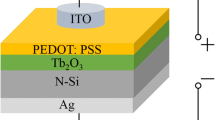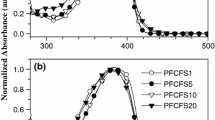Abstract
A new silole monomer with two 4-(N,N-dimethylamino)phenyl substitutions on silicon atom as designed and synthesized. Three copolymers PF-N-HPS1, PF-N-HPS10 and PF-N-HPS20 were then obtained by copolymerizations of 2,7-fluorene derivatives with the silole monomer at feed ratios of 1%, 10%, and 20%. Their UV-vis absorption, electrochemical, photoluminescent, and electroluminescent (EL) properties were investigated. PF-N-HPS possessed HOMO levels of −5.25–−5.58 eV, and showed green emissions. Using PF-N-HPS as the emissive layer, three different polymer light-emitting diodes were fabricated as device A with ITO/PEDOT/PF-N-HPS/Al, device B with ITO/PEDOT/PF-N-HPS/Ba/Al, and device C with ITO/PEDOT/PF-N-HPS/TPBI/Ba/Al. For the device A, PF-N-HPS only showed very low EL efficiency of 0.06–0.33 cd/A, indicating that the Al cathode could not inject electron efficiently to the emissive polymers containing the 4-(N,N-dimethylamino)phenyl groups. For the device B, low work function Ba supplied better electron injections, and the EL efficiency could be improved to 0.85–1.44 cd/A. TPBI with a deep HOMO level of −6.2 eV could enhance electron transport and hole blocking. Thus modified recombinations and largely elevated EL efficiency of 4.56–7.96 cd/A were achieved for the device C. The separation of the emissive layer and metal cathode with the TPBI layer may also suppress exciton quenching at the cathode interface.
Similar content being viewed by others
References
Corey JY. Siloles: Part 1: Synthesis, characterization, and applications. Adv Organomet Chem, 2011, 59: 1–180
Yamaguchi S, Tamao K. Silole-containing σ- and π-conjugated compounds. J Chem Soc, Dalton Trans, 1998, 3693–3702
Murata H, Malliaras GG, Uchida M, Shen Y, Kafafi ZH. Non-dispersive and air-stable electron transport in an amorphous organic semiconductor. Chem Phys Lett, 2001, 339: 161–166
Chen JW, Law CCW, Lam JWY, Dong YP, Lo SMF, Williams ID, Zhu DB, Tang BZ. Synthesis, light emission, nanoaggregation, and restricted intramolecular rotation of 1,1-substituted 2,3,4,5-tetraphenylsiloles. Chem Mater, 2003, 15: 1535–1546
Li HK, Mei J, Wang J, Zhang S, Zhao QL, Wei Q, Qin AJ, Sun JZ, Tang BZ. Facile synthesis of poly(aroxycarbonyltriazole)s with aggregation-induced emission characteristics by metal-free click polymerization. Sci China Chem, 2011, 54: 611–616
Qin AJ, Zhang Y, Han N, Mei J, Sun JZ, Fan WM, Tang BZ. Preparation and self-assembly of amphiphilic polymer with aggregation-induced emission characteristics. Sci China Chem, 2012, 55: 772–778
Liu JZ, Lam JWY, Tang BZ. Aggregation-induced emission of silole molecules and polymers: fundamental and applications. J Inorg Organomet Polym, 2009, 19: 249–285
Chen JW, Xu B, Yang KX, Cao Y, Sung HHY, Williams ID, Tang BZ. Photoluminescence spectral reliance on aggregation order of 1,1-bis(2′-thienyl)-2,3,4,5-tetraphenylsilole. J Phys Chem B, 2005, 109: 17086–17093
Wang ZQ, Zheng CJ, Liu H, Ou XM, Zhang XH. Efficient and stable non-doped deep-blue organic light emitting diode based on an anthracene derivative. Sci China Chem, 2011, 54: 666–670
Zhang J, Yang Y, He C, Li YF. Red-emission organic light-emitting diodes based on solution-processable molecules with triphenylamine core and benzothiadiazole-thiophene arms. Sci China Chem, 2011, 54: 695–698
Chen HY, Chen JW, Qiu CF, Tang BZ, Wong M, Kwok HS. Efficient and bright OLED based on hexaphenylsilole. SID Digest, 2003, 509–511
Chen JW, Cao Y. Silole-containing polymers: Chemistry and optoelectronic properties. Macromol Rapid Commun, 2007, 28: 1714–1742
Wang F, Luo J, Chen JW, Huang F, Cao Y. Conjugated random and alternating 2,3,4,5-tetraphenylsilole-containing polyfluorenes: synthesis, characterization, strong solution photoluminescence, and light-emitting diodes. Polymer, 2005, 46: 8422–8429
Liu ZT, Zou JH, Chen JW, Huang L, Peng JB, Cao Y. Largely enhanced LED efficiency of carbazole-fluorene-silole copolymers by using TPBI hole blocking layer. Polymer, 2008, 49: 1604–1610
Usta H, Lu G, Facchetti A, Marks TJ. Dithienosilole- and dibenzosilole-thiophene copolymers as semiconductors for organic thin-film transistors. J Am Chem Soc, 2006, 128: 9034–9035
Li ZG, Zhao XY, Li X, Gao ZQ, Mi BX, Huang W. Organic thin-film solar cells: Devices and materials. Sci China Chem, 2012, 55: 553–578
Chu TY, Lu JP, Beaupre S, Zhang YG, Pouliot JR, Wakim S, Zhou JY, Leclerc M, Li Z, Ding JP, Tao Y. Bulk heterojunction solar cells using thieno[3,4-c]pyrrole-4,6-dione and dithieno[3,2-b:2′,3′-d]silole copolymer with a power conversion efficiency of 7.3%. J Am Chem Soc, 2011, 133: 4250–4253
Wang EG, Wang L, Lan L, Luo C, Zhuang WL, Peng JB, Cao Y. High-performance polymer heterojunction solar cells of a polysilafluorene derivative. Appl Phys Lett, 2008, 92: 033307
Liu Z, Wang L, Chen JW, Wang F, Ouyang XY, Cao Y. Synthesis and optoelectronic properties of silole-containing polyfluorenes with binary structures. J Polym Sci Part A Polym Chem, 2007, 45: 756–767
Wang F, Luo J, Yang KX, Chen JW, Huang F, Cao Y. Conjugated fluorene and silole copolymers: Synthesis, characterization, electronic transition, light emission, photovoltaic cell, and field effect hole mobility. Macromolecules, 2005, 38: 2253–2260
Liu ZT, Zhou JH, Chen JW, Liu YQ, Peng JB, Cao Y. Highly efficient red light-emitting diodes based on silole-containing polycarbazole. Acta Polymerica Sinica, 2009, 845–851
Wang F, Wang L, Chen JW, Cao Y. Simple silole-containing polyfluorene for white electroluminescence with simultaneous blue, green, and red emission. Macromol Rapid Commun, 2007, 28: 2012–2018
Zhang K, Liu SJ, Guan X, Duan CH, Zhang J, Zhong CM, Wang L, Huang F, Cao Y. Alkali metal salts doped pluronic block polymers as electron injection/transport layers for high performance polymer light-emitting diodes. Sci China Chem, 2012, 55: 766–771
Huang F, Wu HB, Wang DL, Yang W, Cao Y. Novel electroluminescent conjugated polyelectrolytes based on polyfluorene. Chem Mater, 2004, 16: 708–716
Wu HB, Huang F, Peng JB, Cao Y. High-efficiency electron injection cathode of Au for polymer light-emitting devices. Org Electron, 2005, 6: 118–128
Zhang LJ, He C, Chen JW, Yuan P, Huang L, Zhang C, Cai WZ, Liu ZT, Cao Y. Bulk-heterojunction solar cells with benzotriazole-based copolymers as electron donors: largely improved photovoltaic parameters by using PFN/Al bilayer cathode. Macromolecules, 2010, 43: 9771–9778
He ZC, Zhang C, Xu XF, Zhang LJ, Huang L, Chen JW, Wu HB, Cao Y. Largely enhanced efficiency with PFN/Al bilayer cathode in high efficiency bulk-heterojunction photovoltaic cells with a low bandgap polycarbazole donor. Adv Mater, 2011, 23: 3086–3089
He ZC, Zhong CM, Su SJ, Xu M, Wu HB, Cao Y. Enhanced power-conversion efficiency in polymer solar cells using an inverted device structure. Nat Photonics, 2012, 6: 591–596
Zhang WS, Lu Ping, Wang ZM, Ma YG. Exploration of structure and mechanism of insoluble gels formed in microwave-assisted Suzuki coupling for poly(9,9-dihexylfluorene)s. Sci China Chem, 2012, 55: 844–849
Wang M, Li Y, Xie ZY, Wang LX. Polyfluorenes containing pyrazine units: Synthesis, photophysics and electroluminescence. Sci China Chem, 2011, 54: 656–665
Guo ZS, Liu DA, Wang C, Pei J, Zhou ZL, Zhao LH, Gibson G, Brug J, Lam S, Mao SS. Phosphine oxide-functionalized polyfluorene derivatives: Synthesis, photophysics, electrochemical properties, and electroluminescence performance. Sci China Chem, 2011, 54: 678–684
Author information
Authors and Affiliations
Corresponding author
Additional information
Recommended by QIU Yong (Tsinghua University)
Rights and permissions
About this article
Cite this article
Liu, Z., Hu, S., Zhang, L. et al. Electroluminescence performances of 1,1-bis(4-(N,N-dimethylamino)phenyl)-2,3,4,5-tetraphenylsilole based polymers in three cathode architectures. Sci. China Chem. 56, 1129–1136 (2013). https://doi.org/10.1007/s11426-013-4875-z
Received:
Accepted:
Published:
Issue Date:
DOI: https://doi.org/10.1007/s11426-013-4875-z




